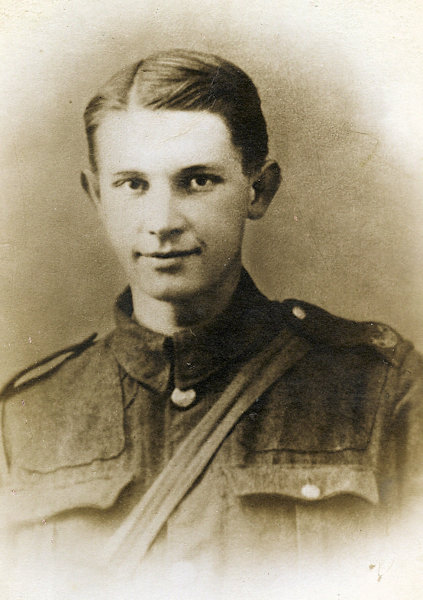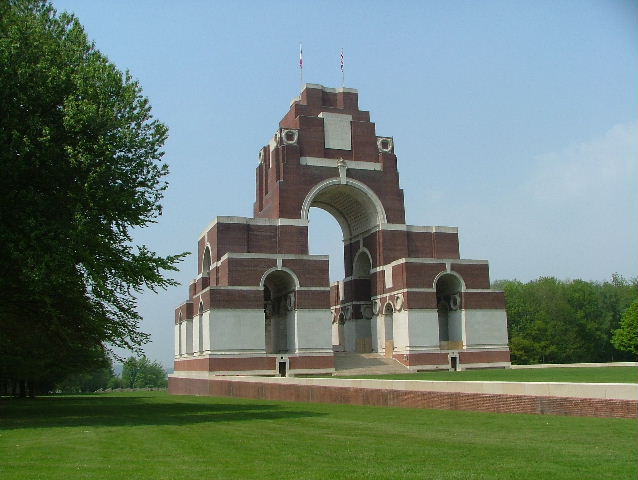Name
David Herbert (poss Hertbert David) Graves
Conflict
First World War
Date of Death / Age
16/08/1916
20
Rank, Service Number & Service Details
Corporal
4007
East Surrey Regiment
9th Bn.
Awards: Service Medals/Honour Awards
Not Yet Researched
Cemetery/Memorial: Name/Reference/Country
THIEPVAL MEMORIAL
Pier and Face 6 B and 6 C.
France
Headstone Inscription
NA
UK & Other Memorials
St Mary’s Church Memorial, Rushden,
Not on the Sandon memorials
Pre War
Born autumn 1895 or 1896 in Sandon, Herts. son of Frank and Minnie Graves, Herbert David but was generally known as David. (Registry detail 3a 493).
1901 census details. The family were living at Beckfield farm in Sandon where father Frank Graves (34) was the farm foreman. His wife Minnie, (31) had 5 children to care for. Cecil was 8, Amelia, 7 Herbert David, 5 Ella P. 3 and Evelyn, 11 months. All were said to have been born in Sandon.
1911 census details. They were living at Offley Green on the lane off the road between Sandon and Rushden. By this time 3 more children had been born, Olive, 9 (the mother of Rev. John Walker of Baldock, formerly of Sandon) Hilda M. 6 and Frank E. 3 (the father of Eve Barker who still lives on Roe Green in Sandon). Mr Frank Graves was now recorded as a domestic gardener , Cecil as a Grocer’s porter and Herbert David as ‘working at home’. They had 5 rooms in their thatched cottage.
Wartime Service
- October 27th. The King inspected the troops.
- 28th. This was the battalion bath day and clean underclothing was issued to the force.
- 31st 2 companies were despatched to the trenches which were wet and ‘fallen in’ on the departure of the previous company and because communication trenches were in such a bad state it was difficult to get rations up to the front.
- November 3rd. The enemy was very quiet even calling across and waving bottles above the parapet.
- 8th. The men had their feet greased with anti-frostbite grease. They complained it caused soreness but said at least it kept their feet warmer. (Trenchfoot was the curse of troops’ life because of the cold, wet winter conditions and this could lead to gangrene and even amputation of lower limbs)
- 19th. They were promised a much needed month’s rest behind the lines when the days were filled with training, marches, lectures, church parades and some sporting competitions. Their billets at Tournehem were said to be good!
- December 5th. The diary states that a football matches took place with A, B and D companies taking part against Headquarters! There was a 30/- prize. A boxing ring was also erected and they had a machine gun competition with the Royal West Kent Regiment.
- 25th. Christmas Day. It was a fine day and the men played football in the morning, attended church service at noon, had a “colossal feed at 1pm of chicken, fruit and plum pudding” and had a concert in the afternoon.
- Normal training continued after that until January.
- January 7th. Troops were moved to the trenches north of the Menin Road between Ypres and Hooge . Enemy activity in the next week resulted in casualties.
- 14th. They moved back to camp near Poperinghe until 31st then back to the same trenches until 7th.
- 7th-19th. They went to the Zillebeke Dugouts for a rest but the H.Q. was badly shelled.
- 19th Back to the Hooge trenches where sniping was a regular occurrence but on several occasions the German soldiers shouted over “Tommy” and “friend”. It was certainly not ALL aggression on the part of the ordinary ranks on both sides as no doubt they were all tired of the conditions, food and continuous discomfort!
- 24th-27th. Back to Zillebeke for rest and recovery for those who made it unscathed.
- March 1st. and 2nd. Heavy activity was suffered in the trenches with trench mortars and ‘whizbangs’ being exchanged regularly.
- 16th. Back in Zillebeke and news was heard that awards had been granted to Temp. 2nd. Lt. Gerald Spencer Tetley a Military Cross and Distinguished Conduct Medals to Privates Jewson and O’Connell. This raised morale.
- April Brought daily casualties to trench bound troops and working parties .
- May and June were also bad and there was a definite increase in enemy activity but a major plan was being made for a massive attack down in the Somme area to take the pressure off the French struggling at Verdun. Thus the 9th East Surreys were to leave the Belgium area.
- July 1st this was the first day of the dreadful infamous Battle of the Somme when so many lives were lost but our lads didn’t arrive down in the area, at Morlancourt until 24th. They were in training here behind the lines until further orders were received.
- August 9th. They were to relieve the 1/5th. North Lancs. Regiment in reserve trenches. This happened on 13th. and C and D companies went in whilst A&B were left behind in training. The reserve trenches were 1 mile S.W. of Guillemont. Then they were moved up to relieve 8th. Queen’s in the front line trenches W. and S.E. of Arrowhead Copse. (see map and war diary for 16th enclosed) ready for the attack on:
16th. August.
Additional Information
David is also commemorated on his family’s grave in Standon (St. Mary) Churchyard. His part of the inscription reads:
AND OF DAVID THEIR SON [Frank And Minnie Graves] LOST IN ACTION IN FRANCE AUG. 16TH 1916 AGED 20 YEARS.
AND WITH THE MORN THOSE ANGEL FACES SMILE WHICH HAVE LOVED LONG SINCE AND LOST AWHILE
Acknowledgments
Malcolm Lennox, Richard Pullen, Jean Handley



